Abstract
This study aims to explore the role of graphene in enhancing the radiation resistance of epoxy resin (EP) composites. Through the resin transfer molding process, we prepared 0.3 wt% graphene oxide (GO) and Hummer’s method reduced graphene oxide (Hh-RGO) reinforced EP composites, respectively. By comparing the microstructure, free radical content, thermal stability, and mechanical properties of EP, GO/EP, and Hh-RGO/EP composites before and after γ-ray irradiation, we found that GO and Hh-RGO can effectively reduce the generation of free radicals in EP during irradiation, thereby reducing chemical bond breakage and enhancing its radiation resistance. Particularly, GO demonstrated stronger radiation damage resistance. The results showed that after γ-ray irradiation, the glass transition temperature, nano-indentation depth, and hardness of GO/EP composites decreased by 20.32%, 416.3 nm, and 16.00%, respectively, whereas EP decreased by 30.34%, 502.1 nm, and 41.82% respectively. This is mainly attributed to the fact that the addition of graphene nanoparticles as a reinforcement reduces the free radical content in EP and reduces the damage of free radicals to the EP crosslinked network during irradiation, thereby improving the thermal stability and mechanical properties of the composites. In addition, the Π electrons formed by the hexagonal honeycomb structure of GO and the Π-Π stacking effect formed with free radicals can slow down the aging of epoxy resin in a high-energy radiation environment, thereby prolonging its service life. This study provides important references for further optimization and application of graphene-modified epoxy resin.
1. Introduction
Epoxy resin (EP) composites are extensively utilized in the aerospace industry due to their lightweight nature and exceptional performance. In space environments, materials inevitably face exposure to high-energy γ radiation. For polymer matrix materials such as epoxy resin formed through crosslinking reactions, the free radicals produced by high-energy particle irradiation can cause molecular chain breakage or crosslinking [1,2]. At low doses (1–500 kGy) of γ radiation, crosslinking reactions typically outweigh chain scission reactions in polymers. Chemical bond rupture generally becomes the predominant effect under high radiation doses [3,4]. When crosslinking reactions prevail, they can compensate for certain defects in the polymer itself, resulting in a slight enhancement in the mechanical properties, thermal stability, and dimensional stability of the polymer [5,6]. On the other hand, when chain scission reactions become predominant, high-energy radiation introduces numerous defects such as cracks, atomic displacement, and gas evolution, leading to degradation of the microstructure and crosslinking network, ultimately causing the deterioration of the polymer and a decrease in the mechanical properties and thermal stability. This can result in radiation-induced oxidative degradation of epoxy resin in a γ irradiation environment [7,8]. Materials employed in aerospace applications and nuclear reactors are usually exposed to high doses of radiation during operation. Therefore, it is necessary to modify the resin further to enhance the overall protection capability of epoxy resin-based composites in complex environments.
Currently, the main approach to mitigate the radiation-induced oxidative degradation effects is to incorporate antioxidants or a small amount of inorganic nano-particle fillers into the polymer matrix. Among them, nanoscale particles, as fillers, can effectively enhance the radiation resistance of polymer materials due to their larger surface area and unique microstructure [9,10,11,12,13]. GO is a two-dimensional planar structure composed of a regular hexagonal crystal structure formed by carbon atoms in a honeycomb lattice arrangement with sp2 hybridized orbitals. It has high thermal conductivity, excellent mechanical properties, and the ability to reduce the activation energy of free radicals [14,15,16,17,18,19,20,21]. Hu, C. et al. [22] prepared graphene oxide-carbon nanotubes nanostructures decorated with nickel nanoparticles (NiGNT) using the molecular-level mixing method. These structures were then applied as reinforcements to enhance the epoxy resin matrix. The composites exhibited improved thermal and electrical conduction performances, which were attributed to the aligned distribution of the NiGNT. Compared to pure epoxy and randomly distributed composites, the composites with aligned NiGNT demonstrated enhanced anisotropic thermal and electrical conduction properties. Mostovoy, A.S. et al. [23] demonstrated the possibility of achieving directional control of the operational properties of epoxy composites by using small additives of thermally expanded graphite-graphene structures. They found that this addition resulted in a 32% increase in bending failure stress and a 44% increase in bending elastic modulus. Furthermore, the compression strength increased by 49%, the tensile strength increased by 74%, and the tensile elastic modulus increased by 34%. The impact resilience also significantly increased by 78%. Additionally, the inclusion of thermally expanded graphite led to improved thermal, fire, and heat resistance properties, as well as an increased coefficient of heat conduction in the epoxy composite. Wu, S. et al. [24] proposed a novel method to attach graphene nanoplatelets (GNPs) with Fe3O4 nanoparticles, enabling their alignment within an epoxy matrix using a weak magnetic field. Compared to unmodified epoxy, the resultant epoxy polymer nanocomposites, which consisted of randomly oriented Fe3O4/PVP-GNPs nanohybrids, exhibited significantly improved electrical conductivity, up to three orders of magnitude, and fracture energies, up to 300%. Notably, aligning the Fe3O4/PVP-GNPs nanohybrids perpendicular to the direction of crack propagation further increased the fracture energy by 50% and enhanced the electrical conductivity by seven-fold in the alignment direction, in contrast to nanocomposites with randomly oriented nanohybrids.
Xia et al. [25] demonstrated the efficient free radical scavenging capability of GO/phenol–formaldehyde composites under irradiation. Zhang et al. [26] proved through experiments such as circular dichroism that surface defects of GO can adsorb oxygen-containing free radicals such as O2·−, and surface oxygen-containing groups such as quinone structures can consume O2·− radicals by single-electron reduction to semi-quinone structures, ultimately quenching the oxygen. Kolanthai et al. [27] dispersed GO into polyethylene (PE) resin to prepare GO/PE composites and subjected them to γ irradiation at a dose of 50 kGy. The results showed that GO can effectively reduce the free radical content in the coating, thereby slowing down the radiation-induced oxidative aging rate of the composite coating. Lin et al. [28] prepared reduced graphene oxide (RGO)/poly (methyl methacrylate) (PMMA) nanocomposites through latex blending and in situ reduction and studied their radiation resistance. It was found that RGO can act as a free radical scavenger to delay the thermal oxidation degradation of the PMMA matrix. Li et al. [29] also demonstrated the ability of phosphorus-doped GO quantum dots to scavenge free radicals. Anson-Casao et al. [30] studied the effect of γ radiation on the structure and composition of chemically synthesized multilayered GO materials and found that when GO is used as a filler in polymer composites, it acts as both a free radical scavenger and a crosslinking initiator. These studies all indicate that graphene materials have the ability to scavenge free radicals in the resin matrix of composite materials, which helps reduce radiation-induced damage such as chemical bond rupture and atomic displacement in polymers and improve the mechanical properties, thermal stability, and dimensional stability of the polymers. However, further investigation is needed to understand how graphene forms stronger chemical bonds with the matrix and exerts its free radical scavenging effects.
To investigate the mechanism of anti-γ-ray irradiation damage in graphene/epoxy matrix composites and enhance the irradiation resistance of epoxy matrix composites, this study employed the modified Hummers method to oxidize graphite and prepare GO. The GO was then reduced to Hh-RGO using hydrazine hydrate. The prepared GO and Hh-RGO were homogeneously dispersed in an EP matrix using the solution blending method and resin transfer molding process, respectively. The resulting GO/EP and Hh-RGO/EP composites were characterized by microstructural changes, thermo-mechanical properties, free radical content, and microhardness before and after γ-ray irradiation. The mechanical properties of the epoxy resin-based composites were also investigated after γ-ray irradiation, and the mechanism of graphene-enhanced radiation resistance in the EP matrix was analyzed.
2. Experimental Materials and Methods
2.1. Preparation of GO and Hh-RGO
Natural graphite, phosphoric acid, sulfuric acid, and potassium permanganate were used as raw materials to prepare GO using a modified Hummers method. The dried GO was further chemically reduced to prepare Hh-RGO. A total of 100 mg of GO was weighed and dispersed in 100 mL of deionized water. The dispersion was sonicated for 1 h to achieve uniform dispersion of GO at a concentration of 1 mg/mL. A measure of 2 mL of hydrazine hydrate reagent was added to the uniform GO dispersion and stirred thoroughly. The mixture was then placed in a thermostatic water bath at 95 °C for a reaction time of 24 h. Finally, the mixture was filtered and dried using a freeze dryer to remove excess water, resulting in the dry hydrazine-reduced RGO, named Hh-RGO. The preparation process is shown in Figure 1.
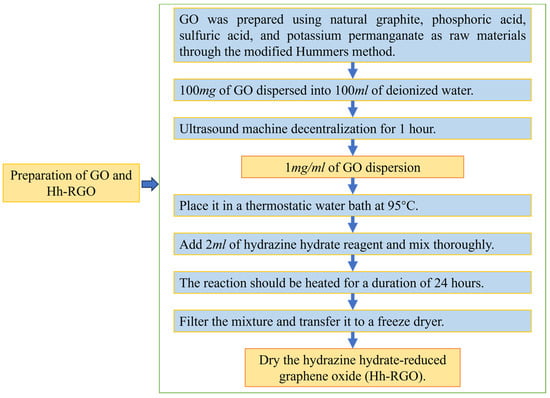
Figure 1.
Preparation of GO and Hh-RGO Flowchart.
2.2. Preparation of GO/EP and Hh-RGO/EP Composite Materials
Using epoxy resin as the reference, EP and 0.3 wt% GO/EP composite materials were prepared using the solution blending method and resin transfer molding process. Firstly, a suitable amount of acetone was weighed to disperse the GO, and the dispersion was treated with constant temperature ultrasonication (25 °C, 1800 W, 1 h) to obtain a uniformly dispersed GO solution. Then, the dispersed GO solution was further exfoliated and dispersed using a high-pressure homogenizer (parameters: pressure of 2.4 kpsi, 3 cycles). Subsequently, the dispersed GO solution was poured into epoxy resin at 60 °C and mixed using magnetic stirring until the acetone completely evaporated. The mixture was then placed in a vacuum oven for degassing. Afterwards, a fixed amount of curing agent was added to the solution (mass ratio of epoxy resin to curing agent = 100:80) and thoroughly mixed using magnetic stirring. The mixture was again degassed in a vacuum oven to remove residual air and degassing was stopped when no more bubbles were detected in the mixture. Finally, the degassed mixture was used to prepare the resin-based composite materials using the resin transfer molding process. During the curing process, the samples were held at 90 °C for 2 h, 110 °C for 1 h, and 130 °C for 4 h. After cooling naturally in the mold, the samples were removed. The dimensions of the prepared samples were length 200 mm, width 10 mm, and thickness 2 mm. In order to prepare comparative samples, EP samples of the same dimensions were prepared using the same method as the GO/EP composite materials, but with 0.3 wt% Hh-RGO in the epoxy resin. The preparation process is shown in Figure 2.
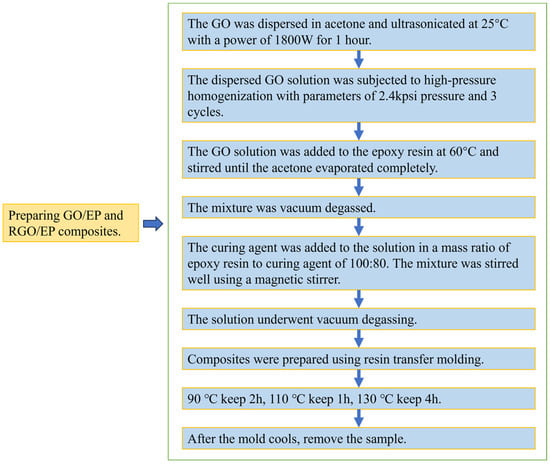
Figure 2.
Preparing GO/EP and Hh-RGO/EP composite materials flowchart.
2.3. Experimental Procedure and Characterization
The γ-ray irradiation experiments were conducted at the No. 2 Cobalt-60 irradiation facility in the Technology and Physics Research Institute of Heilongjiang Academy of Sciences. The EP, GO/EP, and Hh-RGO/EP composite material samples were placed in the irradiation environment of Co-60 γ-rays. The irradiation parameters, including dose rate, total dose, irradiation duration, irradiation atmosphere, and irradiation temperature, were set as follows: dose rate of 25 KGy/h, total dose of 10 MGy, irradiation duration of 400 h, irradiation atmosphere of air, and irradiation temperature at room temperature (25 °C). The irradiated samples were named γ-EP, γ-GO/EP, and γ-Hh-RGO/EP, respectively.
Utilizing a Fourier-transform infrared spectrometer (the Nicolet iS540, Thermo Fisher Scientific, Waltham, MA, USA) and X-ray photoelectron spectroscopy (the D8 DISCOVER, Germany BRUKER, Karlsruhe, Germany), the chemical functional groups and elemental composition of the samples were analyzed. The analysis was performed at 25 °C. Additionally, electron paramagnetic resonance (EPR) detection was carried out using an electron spin resonance spectrometer (Germany Bruker: EMXPLUS A300) to measure the concentration of free radicals generated after irradiation. The capturing agent used for the EPR test was 5,5-dimethyl-1-pyrroline N-oxide. The calculation method for the free radical content is shown in the following equation:
In the equation, Y′m, “∆Hpp”, and I represent the peak-to-baseline peak amplitude, the relative magnetic moment width at the maximum amplitude of each peak, and the concentration of free radicals, respectively. The x-axis represents the magnetic field in units of mT.
The thermal stability of the EP, GO/EP, and Hh-RGO/EP composite materials was evaluated using a dynamic mechanical analyzer (NETZSCH, Selber, Bavaria, Germany, the DMA242E). The hardness of the epoxy resin-based composites materials was tested using a Hysitron TI 980 nanomechanical tester (Bruker, Germany) equipped with a perfect Berkovich indenter. The instrument had a maximum load of 500 mN, with load resolution, maximum indentation depth, and displacement resolution set at 50 nN, 500 µm, and 0.01 nm, respectively.
Following the ASTM D790-03 standard [31], the mechanical properties of the samples were examined using three-point bending tests. The experiments were conducted with five replicates for each sample group, and the average values were calculated. In the nanomechanical testing process, a 3 × 3 matrix was utilized to measure the hardness at nine different positions. The nanomechanical hardness and elastic modulus were determined using the Oliver and Pharr method, as shown in the following formula:
In the formula, Fmax represents the maximum applied load (N), Ac represents the contact area of the probe (mm2), H represents the hardness (GPa), Er represents the elastic modulus (GPa), hc represents the depth of indentation (nm), S is the slope of the unloading curve, and β is a constant value of 1.14 that is related to the geometry of the indenter.
3. Results and Discussion
3.1. Microstructure
Scanning electron microscopy (SEM) was utilized to characterize the micro-morphological features of graphene oxide. Figure 3 shows the SEM images of graphene oxide, with (a) displaying a magnification of 170× and (b) displaying a magnification of 200×. The SEM image in (b) clearly reveals that the prepared GO exhibits a flaky structure with numerous thin folds, where few or single layers are distinctly visible. These surface folds are formed due to the presence of oxygen-containing functional groups on GO, which undergo strong interactions and tend to stack, resulting in fold formation. The presence of folds significantly enhances the surface roughness of graphene oxide, while the reactive functional groups serve as anchor points for subsequent surface modifications with improved reactivity.
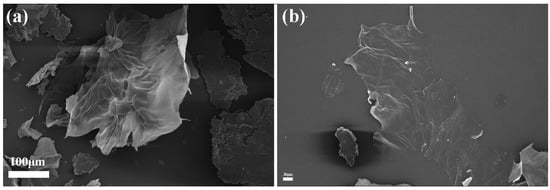
Figure 3.
Scanning electron micrograph of GO. (a) SEM image of oxidized graphene at a magnification of 170×, (b) SEM image of oxidized graphene at a magnification of 200×.
The FTIR spectra of graphite, GO, and Hh-RGO are shown in Figure 4. A comparison with GO reveals that the FTIR spectrum of Hh-RGO exhibits a weakened -OH vibration peak at 3413 cm−1. The absorption peak of C=O at 1726 cm−1 and the vibration absorption peaks of C-O in the epoxy groups at 1204 cm−1 of GO disappear. The intensity of the C-O peak in the epoxy group at 1055 cm−1 also decreases, indicating a reduction in oxygen functional groups and confirming the reduction of GO. GO and Hh-RGO samples were characterized using XPS, and the XPS spectra are shown in Figure 4b. It is evident from Figure 4b that the O peak at 530 eV is higher than the C peak in GO, while in the reduced Hh-RGO, the C peak is significantly higher than the O peak, indicating a decrease in oxygen content and further confirming the reduction of GO.
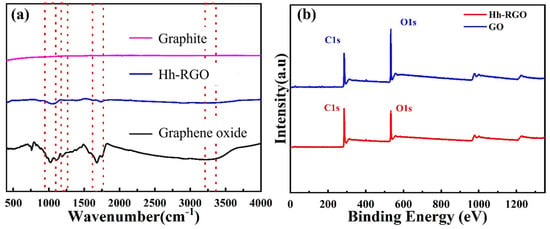
Figure 4.
(a) FTIR spectra of graphite, GO, and Hh-RGO; (b) XPS spectra of GO and Hh-RGO.
Under γ-ray irradiation, the free radicals generated inside the epoxy resin polymer are quite active and react with unstable chemical bonds in the epoxy resin. To explore the effect of γ-ray irradiation on the chemical bonds of different samples, FTIR tests were performed on the γ-irradiated epoxy resin and composites, and the results are shown in Figure 5. The values of 1729 cm−1, 1174 cm−1, and 1040 cm−1 represent the stretching vibrations of C=O double bonds and the aromatic ring skeleton vibrations of C-O and C-O-C, respectively, 1510 cm−1 is the C=C bond of the benzene ring, and the peak at 1598 cm−1 corresponds to the stretching vibration of the C-C bond. From the FTIR spectrum in Figure 5, it can be seen that γ-ray irradiation did not produce new chemical bonds in the treated composites.
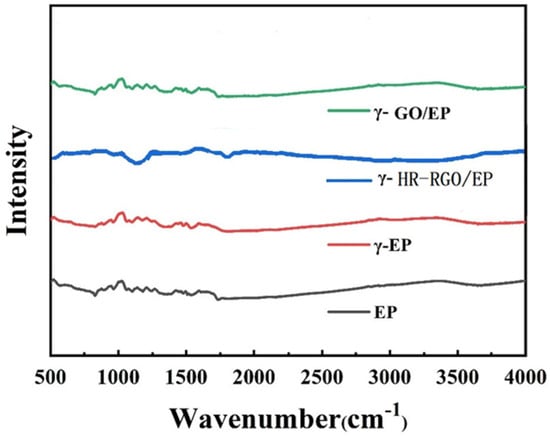
Figure 5.
Infrared Spectra of EP, γ-EP, γ-GO/EP, γ-HR-RGO/EP.
When polymers are irradiated with γ-rays, the free radicals in their molecular structure can undergo crosslinking and chain scission reactions, which can impact the properties of the polymer. In order to investigate the effect of GO and Hh-RGO on the radiation resistance of epoxy resin-based composites, the free radical content of irradiated EP, GO/EP, and Hh-RGO/EP composites was measured using EPR. The results are shown in Figure 6. Figure 6a displays the curves of g-factor and peak intensity for the pure resin and composite materials before and after irradiation. It can be observed from Figure 6a that the g-values of the composite materials are almost the same. The calculation of free radical content was obtained through the first-order integration of the curves in Figure 6 [32], resulting in a g-factor value of 2.003. According to references [33,34], it can be concluded that the free radicals generated after irradiation are peroxide radicals, which can lead to oxidative degradation of the material. Figure 6b presents the curve of magnetic field against free radical intensity. Compared to the pure epoxy resin-based composite, the free radical content of the epoxy resin-based composite with GO added is significantly reduced after irradiation, indicating that GO has the ability to decrease the concentration of free radicals produced in the epoxy resin matrix due to γ-ray irradiation. The peroxide radical concentration in the pure epoxy resin-based composite is almost zero before γ-ray irradiation, serving as the baseline for the curve. The EP composite material shows a significant increase in free radical concentration after γ-ray irradiation, while the GO/EP and Hh-RGO/EP composites exhibit a noticeable decrease in free radical concentration after irradiation. Among them, the decrease in free radical concentration of the Hh-RGO/EP composite is not as significant as that of the GO/EP composite, but compared to the irradiated free radicals in the pure epoxy resin-based composite, the decrease in free radical concentration of the Hh-RGO/EP composite still demonstrates good performance.
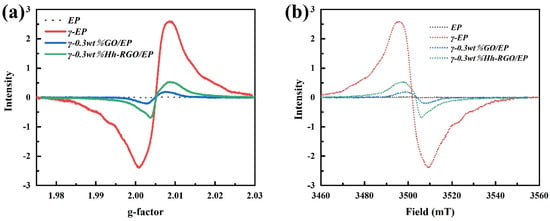
Figure 6.
(a) Curves of g-factor and strength before and after irradiation for EP, GO/EP, and Hh-RGO/EP. (b) Relationship between magnetic field and free radical intensity for EP, GO/EP, and Hh-RGO/EP before and after irradiation.
When the energy absorbed by γ radiation is greater than the bond energy between chemical bonds, it can cause the rupture of chemical bonds or the detachment of functional groups. Among them, atoms or groups with unpaired electrons that are detached from the original structure belong to free radicals. The chemical bond content of the C1s peak in the C element of pure epoxy resin, RGO/EP, and Hh-RGO/EP composites before and after irradiation was studied using X-ray photoelectron spectroscopy (XPS), as shown in Table 1.

Table 1.
Chemical bond content of EP, RGO/EP, and Hh-RGO/EP composite materials before and after γ irradiation.
From Table 1, it can be observed that the pure epoxy resin composite showed significant changes in the C-C bond and C=O bond, increasing by 21.23% and 5.95%, respectively, while the C-O bond decreased by 27.17% after γ irradiation. The increase in the C-C bond can be attributed to the breakage of weaker C-C and C-O bonds in the epoxy resin due to γ radiation. The resulting free radicals then recombine to form new C-C bonds, leading to further crosslinking. This also explains the simultaneous occurrence of crosslinking and degradation during irradiation [35]. However, when GO was incorporated into the epoxy resin, the free radical content in the samples decreased after irradiation. For both GO/EP and Hh-RGO/EP composites, the C-C bond decreased by 23.78% and −13.26%, respectively, while the C=O bond increased by 5.97% and 6.36%, respectively. This can be explained by the reactions between the oxygen-containing functional groups (hydroxyl -OH and carboxyl -COOH) on the GO structure and the epoxy and hydroxyl groups on the epoxy resin, leading to the formation of more stable C=O bonds. Additionally, both GO and Hh-RGO possess a hexagonal honeycomb lattice structure formed by carbon atoms hybridized in the sp2 configuration [36,37]. The main sites of free radical capture in carbon nanomaterials are believed to be within the sp2− carbon regions, which act through the formation of adducts or electron transfer. These regions, similar to benzene rings, can form Π electrons and exhibit Π-Π stacking effects with the free radicals, thus stabilizing them and capturing the free radicals. The locations where free radicals are captured are referred to as active sites, and the number of active sites determines the effectiveness of free radical scavenging. Both GO and Hh-RGO have large specific surface areas, resulting in strong free radical scavenging abilities. However, compared to Hh-RGO, GO has a higher density of oxygen functional groups on its surface, providing more active sites and therefore exhibiting stronger free radical scavenging capabilities.
3.2. Thermal Stability
The thermal stability of EP, GO/EP, and Hh-RGO/EP composites before and after γ radiation was characterized using DMA, as shown in Figure 7. From Figure 7, it can be observed that the glass transition temperature of the pure epoxy resin composite decreased from 104.8 °C to 73 °C after γ radiation, with a decrease of 30.34%, showing the highest degree of decline. The glass transition temperature of the GO/EP composite decreased from 125 °C to 99.6 °C, with a decrease of 20.32%, showing the smallest degree of decline. The glass transition temperature of the Hh-RGO/EP composite decreased from 113.1 °C to 88.1 °C, with a decrease of 22.10% after γ radiation.
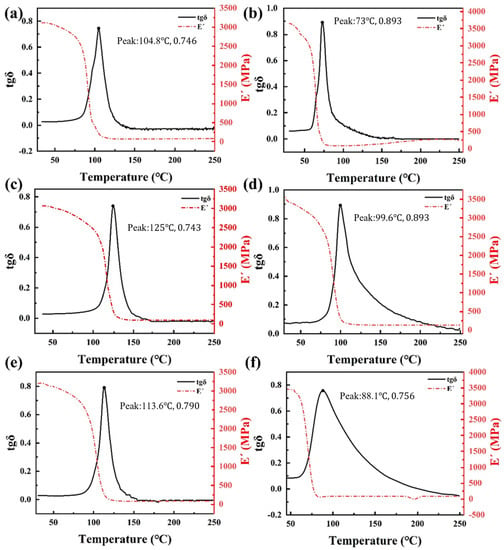
Figure 7.
DMA curves of the samples before and after irradiation: (a,c,e) correspond to EP, GO/EP, and Hh-RGO/EP, respectively; (b,d,f) correspond to EP, GO/EP, and Hh-RGO/EP, respectively.
From Figure 7, it can be observed that the addition of GO and Hh-RGO reinforcements improves the initial thermal decomposition temperature of EP after irradiation, thereby enhancing the thermal stability of EP. This is because the thermal decomposition temperature is closely related to the crosslinking density of the EP matrix, and EP with a higher crosslinking density typically exhibits better thermal stability. The decrease in thermal stability of EP after irradiation is due to the chemical bond cleavage caused by γ radiation, which disrupts the microstructure of EP and reduces its crosslinking degree. The analysis of the test results in Figure 7 suggests that γ radiation generates a large number of free radicals in EP, causing molecular chain breakage and a decrease in crosslinking degree, resulting in a decrease in thermal stability. However, the addition of nanomaterials as reinforcements reduces the content of free radicals in EP, mitigating the damage caused by radiation and improving thermal stability. Among them, the GO/EP composite has the lowest free radical content and exhibits the best thermal stability.
3.3. Mechanical Properties
The micro-nano hardness of EP-, GO-, and Hh-RGO-reinforced EP composites was analyzed using the nanoindentation technique before and after γ radiation, as illustrated in Figure 8. The hardness of the samples was measured under a pressure of 1000 μN. The data from Figure 8 indicate that post γ radiation, the indentation depth of the EP sample rose by 106.4 nm, while the GO/EP composite and Hh-RGO/EP composite saw increases of 95.3 nm and 97.6 nm, respectively. The incorporation of GO and Hh-RGO augments the hardness of the epoxy resin-based composites. Owing to its unparalleled strength and hardness, which exceeds that of diamond, graphene is the strongest known material. Its distinctive layered structure, superior flexibility, and high hardness amplify the impact resistance, flexibility, and hardness of coatings to some degree. After γ radiation, the indentation depth of the Hh-RGO/EP composite surpasses that of the GO/EP composite but remains less than that of EP.

Figure 8.
Load-indentation depth curves of (a) EP, (b) GO/EP, and (c) Hh-RGO/EP before and after γ irradiation.
Figure 9a,b present the nanoindentation hardness and elastic modulus (Er) of the EP, GO/EP, and Hh-RGO/EP composites before and after γ radiation. From Figure 9, it can be observed that the hardness of the different samples decreases after γ radiation. EP shows a reduction of 41.82%, while GO/EP and Hh-RGO/EP exhibit reductions of 16.00% and 19.55% respectively. The decrease in hardness after radiation is attributed to the weakening of chemical bonds caused by irradiation. Additionally, high-dose radiation may generate microdefects within the samples. The incorporation of GO and Hh-RGO as radical scavengers effectively reduces the content of free radicals generated during the radiation process in the resin. Consequently, this reduces the decrease in chemical bond strength and minimizes the occurrence of defect issues resulting from chemical bond cleavage in the samples.
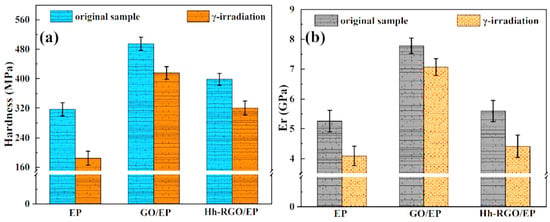
Figure 9.
(a) Hardness and (b) elastic modulus (Er) of the same sample before and after irradiation in.
Bending tests were conducted on the samples before and after irradiation using a three-point bending mode, and the results are shown in Figure 10. From Figure 10, it is evident that the addition of different nano-reinforcements improves the bending strength of the resin to a certain extent before irradiation, with the GO/EP composite exhibiting the highest bending strength. After irradiation, the bending strength of the samples decreases to varying degrees, indicating a reduction in bending strength caused by irradiation. The bending strength of EP decreases by 42.84%, while the bending strength of GO/EP and Hh-RGO/EP composites only decreases by 10.95% and 24.07%, respectively, with a much smaller decrease compared to EP. After irradiation, the flexural strength of EP decreases by 54.91 MPa, which may be attributed to the generation of a large number of free radicals during irradiation, leading to the breakage of molecular chains in EP and consequently reducing the material’s bending strength.
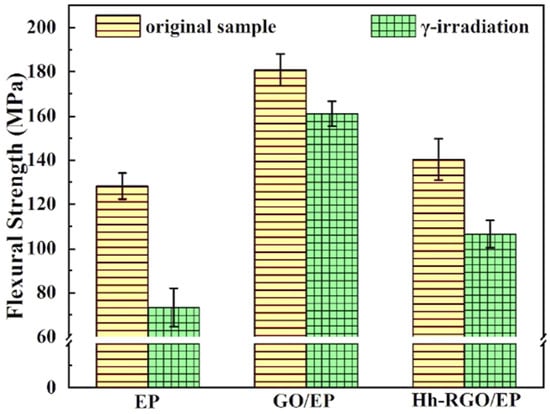
Figure 10.
Bending strength of GO/EP, GO/EP, and Hh-RGO/EP composite materials before and after irradiation.
Compared to EP, the composites reinforced with graphene nanoparticles exhibit a smaller decrease in flexural strength after irradiation. This is primarily due to the fact that both types of graphene nanoparticles can act as radical scavengers, reducing the generation of free radicals during irradiation and thereby minimizing their destructive effects on the crosslinked network of EP. Among the two, GO has the strongest ability to scavenge free radicals, resulting in the least decrease in bending strength after irradiation.
4. Discussion
Laricheva, V. P. [38] proposed that fillers play a significant role in enhancing the radiation resistance of epoxy-based composite materials. Studies have shown that composite materials containing carbon fillers can achieve radiation resistance of 50–100? kGy. However, no further research has been conducted. Yan et al. [39] investigated the effect of adding carbon nanotubes (CNTs) to carbon fiber-reinforced epoxy matrix composites (CF/EP) on their ability to resist γ radiation. The bending strength and bending modulus of γ-CF-CNTs/EP-CNTs were found to be 28.59% and 41.44% higher than that of γ-CF/EP before fatigue testing and 32.19% and 73.51% higher than that of γ-CF/EP after fatigue testing. Ultrasonic C-scan microscopic examination after the fatigue test showed that the internal structure damage of γ-CF-CNTs/EP-CNTs was the smallest, while γ-CF/EP had the largest damage. The storage modulus of the three modified composites was significantly improved compared to the unmodified composite, especially the storage modulus of γ-CF-CNTs/EP-CNTs, which increased sharply from 2.53 GPa (γ-CF/EP) to 5.66 GPa (γ-CF-CNTs/EP-CNTs). Liu et al. [40] investigated the influence of nanoparticles such as carbon black (CB), GO, CNTs, and halloysite nanotubes (HNTs) as free radical scavengers on the radiation resistance of epoxy resin and explored their evolution mechanism. Through analysis of nanoindentation, electron spin resonance, Fourier transform infrared, and X-ray photoelectron spectroscopy of the samples before and after γ-ray irradiation, they found that GO had the most active sites, followed by CNTs, while CB had the weakest effect. HNTs, as electron acceptor sites, were able to remove free radicals. The electron cloud formed by carbon nanomaterials is more stable than that of silicate nanomaterials, which is beneficial for free radical scavenging. Dynamic mechanical property testing showed that the addition of nanoparticles enhanced the radiation resistance of the epoxy resin. Compared to CB/EP, CNTs/EP, and HNTs/EP, GO/EP had the lowest loss in dynamic mechanical properties. After irradiation, the bending strength attenuation rate of the samples was ranked as follows: GO/EP (13.87%) < CNTs/EP (15.92%) < HNTs/EP (17.49%) < CB/EP (18.86%) < EP (29.23%). After irradiation, the decomposition temperature of the samples decreased in the following order: GO/EP (21.4 °C) < CNTs/EP (36.3 °C) < HNTs/EP (37.2 °C) < CB/EP (38.4 °C) < EP (45.7 °C). This is mainly because the addition of nanoparticles reduces the damage of free radicals to the EP crosslinked network.
In this study, the hardness and flexural strength of the samples decreased after γ-ray irradiation. The hardness of EP decreased by 41.82%, and the flexural strength decreased by 42.84%. The hardness and flexural strength of GO/EP composites decreased to a lesser extent, 16.00% and 10.95%, respectively. Hh-RGO/EP composites were the next best, with a decrease of 19.55% in hardness and 24.07% in flexural strength. This is because the π electrons formed by the six-membered ring honeycomb structure of GO can create a π-π stacking effect with free radicals, thus reducing the free radicals generated during irradiation, decreasing the damage of free radicals to the EP crosslinking network and slowing down the aging process of the epoxy resin in the high-energy irradiation environment, which in turn extends its service life.
5. Conclusions
In this study, GO was successfully synthesized using the modified Hummers method, and Hh-RGO was created by reducing GO with a hydrazine hydrate reagent. EP, 0.3 wt% GO/EP, and 0.3 wt% Hh-RGO/EP composites were fabricated using the solution blending method and resin transfer molding process. The microstructural changes, free radical content, thermo-mechanical, and mechanical properties of these composites, both before and after γ-ray irradiation, were characterized using EPR, DMA, nanoindentation, and universal strength machine testing methods.
The results reveal that graphene nanomaterials, acting as free radical scavengers, can effectively reduce the breakage of C-C and C=O bonds induced by γ-ray irradiation, thereby decreasing the irradiation damage. Among them, GO demonstrated the strongest free radical scavenging ability, followed by Hh-RGO. Dynamic mechanical property tests showed that the inclusion of graphene nanomaterials reduced the concentration of free radicals, prevented the fracture of the molecular chain within EP, and enhanced the EP’s irradiation resistance. The primary free radical scavenging sites of graphene nanomaterials are closely tied to the hexagonal honeycomb lattice structure formed by sp2 hybridization of carbon atoms. This structure can function through the formation of adducts or electron transfer. The number of active sites will dictate the ability to scavenge free radicals, with GO possessing the most active sites, making it more effective for scavenging free radicals.
In summary, this study highlights the crucial role of graphene nanomaterials in enhancing the irradiation resistance of graphene oxide-doped modified epoxy resins. Through effective scavenging of free radicals and reduction in irradiation damage, graphene nanomaterials can improve the irradiation resistance of composites, providing a significant reference and guidance for the further improvement and application of graphene oxide-doped modified epoxy resins.
Author Contributions
Conceptualization, X.P., R.S. and Z.X.; methodology, X.P., R.S., Z.X. and H.W.; validation, H.W., S.L., W.W., X.P. and C.Z.; investigation, H.W., S.L., W.W., X.P. and C.Z.; writing—original draft preparation, H.W., X.P. and C.Z.; writing—review and editing, H.W., X.P., C.Z. and Z.X.; data curation, R.S., H.W., S.L., W.W., X.P. and C.Z. All authors have read and agreed to the published version of the manuscript.
Funding
This research was funded by the National Natural Science Foundation of China (NSFC), grant number 12102300 and 12205218.
Institutional Review Board Statement
Not applicable.
Informed Consent Statement
Not applicable.
Data Availability Statement
The data presented in this study are available in the article.
Conflicts of Interest
The authors declare no conflict of interest.
References
- Clare, D.C.; Marissa, A.R.; Erica, M.R.; Avi, G.B.; Khalid, H.; Amanda, S.P.; LaRico, J.F. Fabrication, thermal analysis, and heavy ion irradiation resistance of epoxy matrix nanocomposites loaded with silane-functionalized ceria nanoparticles. Phys. Chem. Chem. Phys. 2022, 24, 6552–6569. [Google Scholar] [CrossRef]
- Liu, L.; Feng, L.; Ma, T.; Xu, Z.; Pei, X.; Liu, Y.; Shi, H.; Tang, Y.; Liu, L.; Deng, H.; et al. Mechanical properties, thermal stability and microstructure evolution of carbon fiber-reinforced epoxy composites exposed to high-dose γ-rays. Radiat. Phys. Chem. 2022, 194, 110056. [Google Scholar] [CrossRef]
- Lin, Y.; Liu, Y.; Zhang, D.; Chen, C.; Wu, G. Radiation resistance of poly(methyl methacrylate)/reduced graphene oxide nanocomposites fabricated through latex mixing and in situ reduction. Chem. Eng. J. 2017, 315, 516–526. [Google Scholar] [CrossRef]
- Cinan, Z.M.; Erol, B.; Baskan, T.; Mutlu, S.; Savaskan Yilmaz, S.; Yilmaz, A.H. Gamma Irradiation and the Radiation Shielding Characteristics: For the Lead Oxide Doped the Crosslinked Polystyrene-b-Polyethyleneglycol Block Copolymers and the Polystyrene-b-Polyethyleneglycol-Boron Nitride Nanocomposites. Polymers 2021, 13, 3246. [Google Scholar] [CrossRef] [PubMed]
- Lu, X.Y.; Chen, L.; Wu, C.Y.; Chan, H.K.; Freeman, T. The Effects of Relative Humidity on the Flowability and Dispersion Performance of Lactose Mixtures. Materials 2017, 10, 592. [Google Scholar] [CrossRef]
- Xu, H.; Liu, D.; Sun, W.-Q.; Wu, R.-J.; Liao, W.; Li, X.-L.; Hu, G.; Hu, H.-S. Study on the Design, Preparation, and Performance Evaluation of Heat-Resistant Interlayer-Polyimide-Resin-Based Neutron-Shielding Materials. Materials 2022, 15, 2978. [Google Scholar] [CrossRef]
- Acevedo-Del-Castillo, A.; Águila-Toledo, E.; Maldonado-Magnere, S.; Aguilar-Bolados, H. A Brief Review on the High-Energy Electromagnetic Radiation-Shielding Materials Based on Polymer Nanocomposites. Int. J. Mol. Sci. 2021, 22, 9079. [Google Scholar] [CrossRef]
- Zaharescu, T.; Mariş, M. Irradiation Effects in Polymer Composites for Their Conversion into Hybrids. J. Compos. Sci. 2022, 6, 109. [Google Scholar] [CrossRef]
- Manzhi, S.; Hong, Z.; Chunyang, L.; Xu, Y.; Zhidong, H.; Zhenguo, Y. Formulation and properties of UV crosslinked low voltage ethylene propylene diene monomer cable insulation material. Acta Mater. Compos. Sin. 2022, 39, 5922–5933. [Google Scholar] [CrossRef]
- Julmi, S.; Abel, A.; Gerdes, N.; Hoff, C.; Hermsdorf, J.; Overmeyer, L.; Klose, C.; Maier, H.J. Development of a Laser Powder Bed Fusion Process Tailored for the Additive Manufacturing of High-Quality Components Made of the Commercial Magnesium Alloy WE43. Materials 2021, 14, 887. [Google Scholar] [CrossRef]
- Gao, Y.; Xu, B.; Han, T.; Wang, X. Gamma-ray irradiation induced variation in charge transport behavior of polyethylene based boron nitride/silica micro/nanocomposites. Materials 2020, 13, 2180. [Google Scholar] [CrossRef]
- Babu, M.; Myneni, R.B.; Sarathi, R.; Vasa, N.; Imai, T. Investigation on space charge and charge trap characteristics of gamma irradiated epoxy micro-nano composites. High Volt. 2020, 5, 191–201. [Google Scholar]
- Lv, J.; Wang, H.; Liu, Y.; Chen, J.; Chen, H.; Xu, J.; Sun, J.; Zhao, H.; Zhu, C. Nanocomposite enhanced radiation resistant effects in polyurethane elastomer with low fraction of polydoapmine nanoparticles. Compos. Sci. Technol. 2020, 186, 107908. [Google Scholar] [CrossRef]
- Dai, S.W.; Zhou, Y.J.; Li, W.D.; Bai, W.; Zhao, H.; Bai, H.; Hu, X. Interlaminar toughening of carbon fiber/epoxy composites with graphene oxide-carbon nanotube composite film. Acta Mater. Compos. Sin. 2023, 40, 3862–3873. [Google Scholar] [CrossRef]
- Hu, Y.; Huang, P.; Wang, F. Graphene distribution and structural integrity dependent irradiation resistance of graphene/tungsten composites. Mater. Today Commun. 2022, 31, 103365. [Google Scholar] [CrossRef]
- Laskar, B.I.; Shukla, P.K. Adsorption of HOOO radical on pristine and doped graphene—A first-principles study. Struct. Chem. 2021, 32, 1171–1179. [Google Scholar] [CrossRef]
- Scalia, T.; Bonventre, L.; Terranova, M.L. From Protosolar Space to Space Exploration: The Role of Graphene in Space Technology and Economy. Nanomaterials 2023, 13, 680. [Google Scholar] [CrossRef]
- Guo, M.; Hei, Y.; Li, B.; Xing, L. Structure, mechanical property, electrical conductivity and lightning strike damage behavior of graphene/carbon nanotube co-modified CFRPs. Acta Mater. Compos. Sin. 2022, 39, 4354–4365. [Google Scholar] [CrossRef]
- Zhang, C.Z.; Shen, Q.Q.; Wang, Y.; Li, T.; Ding, D.Q. Experimental study on mechanisms of reactions of radicals with graphene oxide particles in wastewater. J. Mol. Liq. 2023, 373, 121231. [Google Scholar] [CrossRef]
- Smith, A.T.; LaChance, A.M.; Zeng, S.; Liu, B.; Sun, L. Synthesis, Properties, and Applications of Graphene Oxide/Reduced Graphene Oxide and their Nanocomposites. Nano Mater. Sci. 2019, 1, 31–47. [Google Scholar] [CrossRef]
- Yao, W.J.; Fan, L.; Liu, G.Y. Advance in Properties of Graphene and Graphene/Metal Layered Composite After Irradiation Damage. Rare Met. Mater. Eng. 2019, 48, 3130–3135. Available online: https://www.webofscience.com/wos/woscc/full-record/WOS:000494079600009(overlay:export/ris) (accessed on 1 June 2020).
- Hu, C.; Zhang, H.; Neate, N.; Fay, M.; Hou, X.; Grant, D.; Xu, F. Highly Aligned Ni-Decorated GO–CNT Nanostructures in Epoxy with Enhanced Thermal and Electrical Properties. Polymers 2022, 14, 2583. [Google Scholar] [CrossRef] [PubMed]
- Mostovoy, A.S.; Yakovlev, A.V.; Lopukhova, M.I. Directional control of physico-chemical and mechanical properties of epoxide composites by the addition of graphite-graphene structures. Polym. Plast. Technol. Mater. 2020, 59, 874–883. [Google Scholar] [CrossRef]
- Wu, S.; Zhang, J.; Ladani, R.B.; Ghorbani, K.; Mouritz, A.P.; Kinloch, A.J.; Wang, C. A novel route for tether-ing graphene with iron oxide and its magnetic field alignment in polymer nanocomposites. Polymer 2016, 97, 273–284. [Google Scholar] [CrossRef]
- Wei, X.; Tao, W.; Li, S.; Hao, G.; Hu, G.; Xiaoli, F.; Bin, G.; Jun, Z.; Jianping, H. Graphene/Epoxy Composite Coating Damage under γ-ray Irradiation and Corrosion Protection. J. Inorg. Mater. 2018, 33, 35–40. [Google Scholar] [CrossRef]
- Zhang, C.; Chen, S.; Alvarez, P.J.J.; Chen, W. Reduced graphene oxide enhances horseradish peroxidase stability by serving as radical scavenger and redox mediator. Carbon 2015, 94, 531–538. [Google Scholar] [CrossRef]
- Martínez-Morlanes, M.J.; Castell, P.; Alonso, P.J.; Martinez, M.T.; Puértolas, J.A. Multiwalled carbon nanotubes acting as free radical scavengers in gamma-irradiated ultrahigh molecular weight polyethylene composites. Carbon 2012, 50, 2442–2452. [Google Scholar] [CrossRef]
- Yu, L.; Liu, Y.; Zhang, D.; Wu, G. Radiation resistance of polypropylene composites by incorporating reduced graphene oxide and antioxidant: A comparison study. Compos. Sci. Technol. 2017, 146, 83–90. [Google Scholar] [CrossRef]
- Li, Y.; Li, S.; Wang, Y.M.; Wang, J.; Liu, H.; Liu, X.Q.; Wang, L.F.; Liu, X.G.; Xue, W.D.; Ma, N. Electrochemical synthesis of phosphorus-doped graphene quantum dots for free radical scavenging. Phys. Chem. Chem. Phys. 2017, 19, 11631–11638. Available online: https://www.webofscience.com/wos/woscc/full-record/WOS:000401022300066(overlay:export/exp) (accessed on 1 January 2020). [CrossRef]
- Ansón-Casaos, A.; Puértolas, J.A.; Pascual, F.J.; Hernández-Ferrer, J.; Castell, P.; Benito, A.M.; Maser, W.K.; Martínez, M.T. The effect of gamma-irradiation on few-layered graphene materials. Appl. Surf. Sci. 2014, 301, 264–272. [Google Scholar] [CrossRef]
- ASTM D790-03; Standard Test Methods for Flexural Properties of Unreinforced and Reinforced Plastics and Electrical Insulating Materials. ASTM International: West Conshohocken, PA, USA, 2017. Available online: https://www.astm.org/d0790-03.html (accessed on 30 July 2023).
- Diao, F.; Zhang, Y.; Liu, Y.; Fang, J.; Luan, W. γ-Ray irradiation stability and damage mechanism of glycidyl amine epoxy resin. Nucl. Instrum. Methods Phys. Res. Sect. B Beam Interact. Mater. At. 2016, 383, 227–233. [Google Scholar] [CrossRef]
- Xia, W.; Li, J.; Zhang, S.; Jiang, C.; Feng, Y.; Zhao, J.; Lin, Z.; Huang, X.; Wang, T.; He, J. In Situ Synthesis of Graphene-Phenol Formaldehyde Composites and Their Highly-Efficient Radical Scavenging Effects under the γ Irradiation. Corros. Sci. 2019, 159, 108139. [Google Scholar] [CrossRef]
- Marrale, M.; Longo, A.; Panzeca, S.; Gallo, S.; Principato, F.; Tomarchio, E.; Parlato, A.; Buttafava, A.; Dondi, D.; Zeffiro, A. ESR response of phenol compounds for dosimetry of gamma photon beams. Nucl. Instrum. Methods Phys. Res. Sect. B Beam Interact. Mater. At. 2014, 339, 15–19. [Google Scholar] [CrossRef]
- Chang, L.; Zhang, Y.; Liu, Y.J.; Fang, J.; Luan, W.J. Study on the damage mechanism for epoxy resin under gamma irradiation. Thermosetting Resin 2016, 31, 10–14. Available online: https://jglobal.jst.go.jp/en/detail?JGLOBAL_ID=201702249560588765 (accessed on 1 January 2020).
- De Volder, M.F.L.; Tawfick, S.H.; Baughman, R.H.; Hart, A.J. Carbon Nanotubes: Present and Future Commercial Applications. Science 2013, 339, 535–539. [Google Scholar] [CrossRef]
- Castro Neto, A.H.; Guinea, F.; Peres, N.M.R.; Novoselov, K.S.; Geim, A.K. The Electronic Properties of Graphene. Rev. Mod. Phys. 2009, 81, 109–162. [Google Scholar] [CrossRef]
- Laricheva, V.P. Radiation resistance of epoxy oligomers and prospects of creating new epoxy-oligomer based materials for space structures. In Proceedings of the 11th International Symposium on Materials in a Space Environment, Aix-en-Provence, France, 15–18 September 2009; Available online: http://esmat.esa.int/Materials_News/ISME09/pdf/4-New/Poster%20New%20Materials%20and%20Technologies%20-%20Laricheva.pdf (accessed on 1 June 2020).
- Yan, M.; Liu, L.; Chen, L.; Li, N.; Jiang, Y.; Xu, Z.; Jing, M.; Hu, Y.; Liu, L.; Zhang, X. Radiation Resistance of Carbon Fiber-Reinforced Epoxy Composites Optimized Synergistically by Carbon Nanotubes in Interface Area/Matrix. Compos. Part B Eng. 2019, 172, 447–457. [Google Scholar] [CrossRef]
- Liu, Y.; Zhang, S.; Pei, X.; Shi, H.; Li, D.; Xu, Z.; Li, S.; Xue, Y.; Song, L. Free radical scavenging behavior of multidimensional nanomaterials in γ-irradiated epoxy resin and mechanical and thermal performance of γ-irradiated composites. Compos. Part C 2021, 4, 100095. [Google Scholar] [CrossRef]
Disclaimer/Publisher’s Note: The statements, opinions and data contained in all publications are solely those of the individual author(s) and contributor(s) and not of MDPI and/or the editor(s). MDPI and/or the editor(s) disclaim responsibility for any injury to people or property resulting from any ideas, methods, instructions or products referred to in the content. |
© 2023 by the authors. Licensee MDPI, Basel, Switzerland. This article is an open access article distributed under the terms and conditions of the Creative Commons Attribution (CC BY) license (https://creativecommons.org/licenses/by/4.0/).